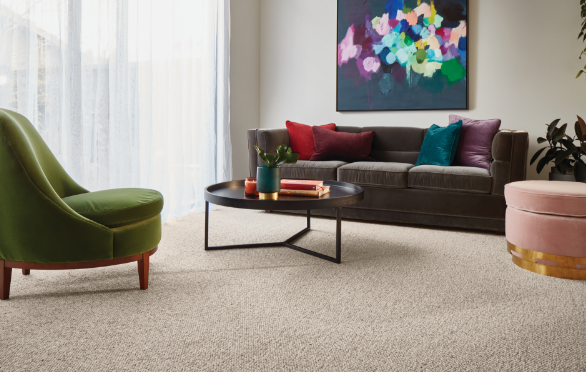There are a number of considerations when choosing the type of carpet for your home or business. A major one is whether to choose nylon or wool. Without a doubt more nylon carpets are sold worldwide than wool, making nylon the popular choice, but is it necessarily the best choice for your needs? Visit our Wollongong carpet showroom to see for yourself.
What is Wool?
You will often hear wool described as natural, but what benefits do you really get from wool being natural? Wool, which is composed of a water insoluble protein substance called keratin, mainly comes from sheep. It has crimps and curls that create pockets and give it a luxuriously soft cushiony feel.

Resiliency refers to a fibre’s ability to return to its original form or position after being compressed or stretched. Though not as resilient as nylon, wool is a naturally resilient fibre. While wool’s resistance to abrasion is not as high as that of nylon or triexta, wool is generally able to retain its texture well and is generally quite durable.

Wool is not as stain resistant as nylon, or most synthetic fibres for that matter. In fact, wool is quite absorbent, so it can be difficult to remove stains once they have been absorbed by the fibre. As with all fibres, it is best to treat the spill as quickly as possible to prevent staining. If the substance is allowed to soak into the fibre, it may not come out.
Soiling, however, is different from staining. In this regard, wool does have good resistance to soiling. As a natural fibre, wool has microscopic scales that prevent dirt from settling into the fibre. Dirt particles, instead, sit on top of the carpet making them easier to remove.These microscopic scales also mask any soiling that may occur.

Wool fibres have a thin waxy coating of fatty acids that prevent the growth of mould, mildew and bacteria. This also means wool carpets don’t have to be cleaned as often as, and will smell fresh longer than synthetic ones.

Owing to its highly absorbent nature, wool will absorb excess moisture in the air. Conversely, when the air is dry, the fibres will release the moisture. This helps regulate the humidity in your home or office.

Without a doubt, wool carpets are more expensive than their synthetic counterparts. However, wool is seen by many as an investment, hence the high price tag. Over the years, due to wools popularity, more cost effective options have become available. Wool carpets can last for many years when properly maintained and selected according to household conditions.

